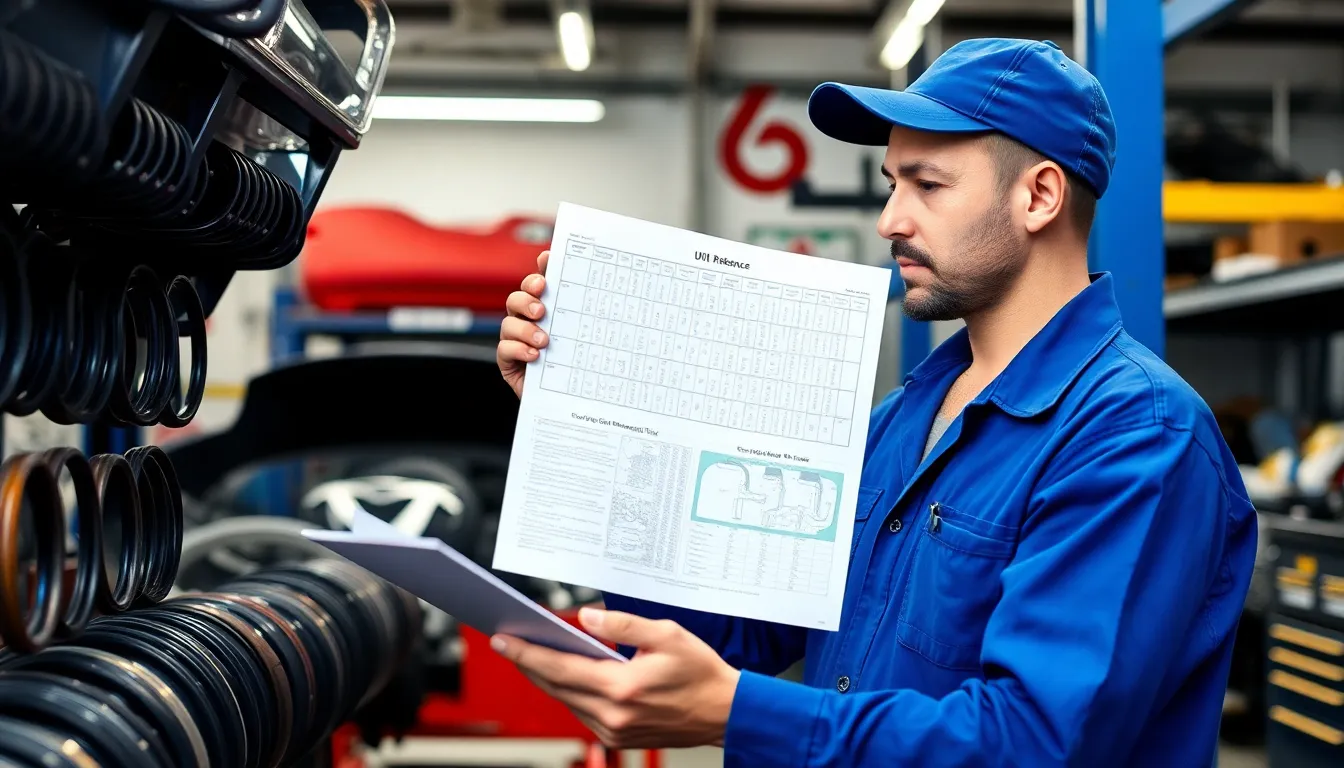Navigating the world of oil seals can feel like trying to find a needle in a haystack—if that needle were also covered in grease and hidden under a pile of confusing part numbers. But fear not! The national oil seal cross reference chart is here to save the day. This handy tool helps mechanics and DIY enthusiasts alike match seals from various manufacturers, ensuring they get the right fit without the headache.
Table of Contents
ToggleOverview of National Oil Seal Cross Reference Chart
National oil seal cross reference charts serve as essential tools in automotive repair and maintenance. They simplify the process of identifying appropriate oil seals across various brands. By consulting these charts, mechanics can locate compatible oil seals without extensive part number searches.
Manufacturers often use different numbering systems for similar products, making it difficult to find the correct seal. A cross reference chart consolidates this information, streamlining the matching process. Users easily input their seal’s part number to discover alternative options that ensure optimal performance.
These charts typically include details like dimensions, material types, and sealing capabilities. Access to such specifications helps mechanics make informed choices, facilitating repairs with precision. For DIY enthusiasts, this resource removes ambiguity when sourcing oil seals for specific applications.
Understanding the importance of a national oil seal cross reference chart highlights its role in reducing downtime during repairs. Time saved translates directly into cost savings for businesses and individuals alike. Additionally, utilizing these charts increases the likelihood of encountering fewer leaks and ultimately enhances vehicle reliability.
Users often report improved efficiency when referencing these charts. The clarity of the information assists in making quick decisions, aligning with the urgency of repair situations. Access to a comprehensive chart adds value to any workshop, enhancing customer service quality and ensuring satisfaction.
Importance of Using a Cross Reference Chart

Using a cross reference chart streamlines the process of identifying the correct oil seals. This resource saves time for both mechanics and DIY enthusiasts, enhancing their repair efficiency.
Benefits for Repair Professionals
Repair professionals benefit significantly from using a cross reference chart. Quick access to compatible seal options reduces time spent searching for parts. Increased accuracy leads to fewer returns due to incorrect fittings. These charts enhance productivity by enabling faster decision-making and replacement tasks. Cost savings also come into play, as reduced downtime translates to more jobs completed within shorter timeframes. Satisfied customers result from timely repairs and minimized leaks, fostering trust in the service provided.
Accuracy in Seal Selection
Accuracy in seal selection is critical to ensuring long-term vehicle performance. A cross reference chart provides reliable alternatives based on part numbers, minimizing potential errors. This tool simplifies the complicated numbering systems from various manufacturers. It allows users to view detailed specifications, including dimensions and materials, which aids in making informed choices. Improved accuracy directly correlates with reduced chances of leaks, thus enhancing overall vehicle reliability. Fewer replacements and repair calls occur when the right seals are selected initially, contributing to a more efficient repair process.
How to Read the National Oil Seal Cross Reference Chart
Reading the national oil seal cross reference chart involves understanding specific elements and details critical for selection. Mechanics and DIY enthusiasts benefit from knowing how to interpret the information effectively.
Understanding Seal Numbers
Seal numbers represent unique identifiers for oil seals across different manufacturers. Each manufacturer may use a different numbering system, making it challenging to identify compatible seals. When using the cross reference chart, users must input their current seal’s part number. The chart then displays corresponding numbers from various brands, allowing for an easy comparison. This process ensures the correct selection of seals, improving repair accuracy and minimizing potential leaks.
Key Symbols and Terms
Familiarity with symbols and terms enhances the ability to navigate the chart. Common symbols include the diameter and width measurements, typically measured in millimeters or inches. Terms such as “lip type” describe the design, while “material” indicates the substance used, such as rubber or polyurethane. Understanding these key elements provides clarity and aids in making informed decisions. Users can quickly identify the right specifications for their vehicles, ensuring compatibility and maintaining optimal performance.
Common Applications of National Oil Seal Cross Reference Charts
National Oil Seal Cross Reference Charts find applications across various industries including automotive, manufacturing, and marine. Mechanics use these charts to identify compatible oil seals swiftly, enhancing repair efficiency. Automotive repair shops benefit greatly from having ready access to this resource, leading to faster turnaround times for vehicle repairs.
Manufacturers also rely on these charts for quality assurance. Accurate identification of components minimizes risks associated with defective seals. Ships and boats use oil seals in their engines and hydraulic systems, where compatibility is crucial. Accessing a cross reference chart helps marine technicians avoid costly leaks, contributing to safer operations.
Heavy equipment operators utilize these charts for construction machinery as well. These environments require durable seals that withstand harsh conditions. By cross-referencing seal numbers, technicians ensure they choose the right components for long-lasting performance.
In addition, agricultural equipment maintenance relies heavily on these resources. Farmers necessitate reliable machinery for productivity; therefore, using a cross reference chart helps them select the appropriate seals, reducing downtime during peak seasons.
Additionally, off-road vehicles require proper seal selections to maintain performance in challenging terrains. Knowledge of cross-referenced parts aids in preventing mechanical failures during expeditions.
Construction and mining industries also utilize these charts to ensure machinery runs efficiently. Accurate selection of seals leads to extended machinery lifespan and improved operational efficiency.
Overall, the versatility of National Oil Seal Cross Reference Charts in various sectors highlights their importance. Easy access to compatible part numbers enhances productivity, reduces costs, and enhances customer satisfaction.
Tips for Choosing the Right Oil Seal
Selecting the correct oil seal requires attention to detail. Start by confirming the dimensions of the seal, including inner and outer diameter as well as width. Evaluating the lip type is crucial for maintaining proper functionality. Consider the material, as different environments demand specific materials for optimal performance.
When comparing seals, refer to the national oil seal cross reference chart. This chart provides vital compatibility information across various manufacturers. Look for unique identifiers in the seal numbers, ensuring correct matches. Using a chart minimizes errors usually encountered with complex part numbers.
Assessing application needs plays a significant role in the selection process. Certain seals perform better in automotive applications, while others suit marine or heavy equipment use. Understanding the application helps avoid costly mistakes during installation.
Pay attention to environmental factors during the selection process. Extreme temperatures, chemicals, or pressures may affect seal integrity. Opting for seals specifically designed for these conditions enhances performance longevity.
Lastly, keep in mind that access to accurate information aids decision-making. With a reliable cross reference chart, choosing the right seal becomes straightforward. Mechanic workshops, manufacturers, and DIY enthusiasts benefit from reducing downtime and increasing efficiency. Prioritizing these aspects ensures smooth operations and fosters customer satisfaction.
Utilizing a national oil seal cross reference chart is crucial for anyone involved in automotive repair or maintenance. This resource simplifies the process of finding compatible oil seals, ultimately enhancing efficiency and reducing downtime. By understanding how to navigate the chart and interpret its details, users can make informed decisions that lead to better vehicle performance.
The benefits extend beyond just quick access to information. Accurate seal selection minimizes the risk of leaks and costly repairs, ensuring customer satisfaction. Whether in automotive, marine, or heavy machinery applications, the national oil seal cross reference chart proves to be an invaluable tool for professionals and enthusiasts alike. Embracing this resource can significantly elevate repair quality and operational productivity.



